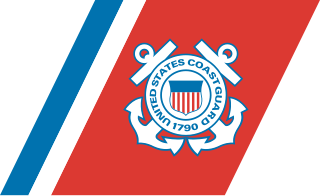The United States Armed Forces are the military forces of the United States. The armed forces consists of six service branches: the Army, Marine Corps, Navy, Air Force, Space Force, and Coast Guard. The president of the United States is the commander-in-chief of the armed forces and forms military policy with the Department of Defense (DoD) and Department of Homeland Security (DHS), both federal executive departments, acting as the principal organs by which military policy is carried out. All six armed services are among the eight uniformed services of the United States.

The United States Coast Guard (USCG) is the maritime security, search and rescue, and law enforcement service branch of the United States Armed Forces and one of the country's eight uniformed services. The service is a maritime, military, multi-mission service unique among the United States military branches for having a maritime law enforcement mission with jurisdiction in both domestic and international waters and a federal regulatory agency mission as part of its duties. It is the largest and most powerful coast guard in the world, rivaling the capabilities and size of most navies.

The Eurocopter MH-65 Dolphin is a twin-engined helicopter operated by the United States Coast Guard (USCG) for medevac-capable search and rescue (SAR) and armed Airborne Use of Force missions. It is a variant of the French-built Eurocopter AS365 Dauphin.

"Anchors Aweigh" is the fight song of the United States Naval Academy and unofficial march song of the United States Navy. It was composed in 1906 by Charles A. Zimmermann with lyrics by Alfred Hart Miles. When he composed "Anchors Aweigh", Zimmermann was a lieutenant and had been bandmaster of the United States Naval Academy Band since 1887. Miles was midshipman first class at the academy, in the class of 1907, and had asked Zimmermann to assist him in composing a song for that class, to be used as a football march. Another academy midshipman, Royal Lovell, later wrote what would be adopted into the song as its third verse.
The Air and Space Training Ribbon is the lowest military award of the United States Air Force, ranking only above foreign military awards.

The United States Coast Guard Reserve is the reserve component of the United States Coast Guard. It is organized, trained, administered, and supplied under the direction of the Commandant of the Coast Guard through the Assistant Commandant for Reserve (CG-R).

The Meritorious Service Medal (MSM) is a military award presented to members of the United States Armed Forces who distinguished themselves by outstanding meritorious achievement or service to the United States subsequent to January 16, 1969.
The Basic Training Honor Graduate Ribbon is the informal collective name for three equivalent United States military awards for the Navy, Air Force, and Coast Guard recruits who graduate at the top of their basic training classes: The Air Force Basic Military Training Honor Graduate Ribbon, the Coast Guard Basic Training Honor Graduate Ribbon, and the Navy Recruit Honor Graduate Ribbon.

United States military bands include musical ensembles maintained by the United States Army, United States Marine Corps, United States Navy, United States Air Force, and United States Coast Guard. More broadly, they can also include musical ensembles of other federal and state uniformed services, including the Public Health Service and NOAA Corps, the state defense forces, and the senior military colleges.
The United States military inter-service awards and decorations are those medals and ribbons which may be awarded to all members of the six military branches of the U.S. Armed Forces. Each military department awards inter-service awards under the same criteria.

The United States Coast Guard (USCG) Women's Reserve, also known as the SPARS, was the women's branch of the United States Coast Guard Reserve. It was established by the United States Congress and signed into law by President Franklin D. Roosevelt on 23 November 1942. This law authorized the acceptance of women into the reserve as commissioned officers and at the enlisted level for the duration of World War II plus six months. Its purpose was to release officers and men for sea duty and to replace them with women at shore stations. Dorothy C. Stratton was appointed director of the SPARS with the rank of lieutenant commander and later promoted to captain.

A Coast Guard Air Station provides aviation support for the United States Coast Guard. The Coast Guard operates approximately 210 aircraft from 24 Coast Guard Air Stations in the United States. Fixed-wing aircraft, such as the HC-130 Hercules, are built for long range missions and operate from air stations. The MH-65D Dolphin and Sikorsky HH-60 Jayhawk helicopters also operate from Air Stations, Air Facilities and flight deck equipped cutters.

The United States Coast Guard Ceremonial Honor Guard is a unit of the United States Coast Guard responsible for the performance of public duties. Stationed in Alexandria, Virginia, the unit was activated in 1962.

The United States Navy Ceremonial Guard is the official ceremonial unit of the United States Navy. It is responsible for the performance of public duties in the U.S. Navy. The guard is composed of 200 enlisted navy personnel. It is based at Naval District Washington, Washington Navy Yard, Washington D.C. It is currently led by Commander Dave Tickle.

The Armed Forces Medley, also known as the Armed Forces Salute is today recognized as a collection of the official marchpasts/songs of the 6 services of the United States Armed Forces: Army, Marine Corps, Navy, Air Force, Coast Guard, and as of 2020 the Space Force. The medley is usually played in increasing order of precedence:
- Semper Paratus
- Semper Supra
- The U.S. Air Force
- Anchors Aweigh
- Marines' Hymn
- The Army Goes Rolling Along
"Semper Supra" is the official march of the United States Space Force, composed in 2022 by James Teachenor and Sean Nelson.

















